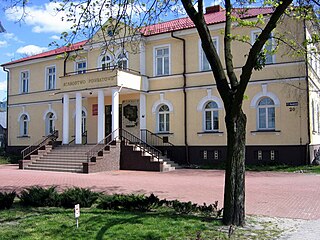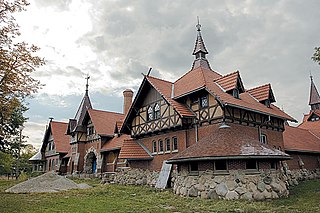
Katowice is a city in southern Poland, the capital city of the Silesian Voivodeship, and a member town of the Upper Silesia and Dąbrowa Basin Metropolis. With the population of 294,510, it is the eleventh-largest city in Poland. The wider Katowice urban area has the population of approximately 2 million people.

Andrzej Tadeusz Bonawentura Kościuszko was a Polish-Lithuanian military engineer, statesman, and military leader who became a national hero in Poland, Lithuania, Belarus, and the United States. He fought in the Polish–Lithuanian Commonwealth's struggles against Russia and Prussia, and on the U.S. side in the American Revolutionary War. As Supreme Commander of the Polish National Armed Forces, he led the 1794 Kościuszko Uprising.

Kutno is a town located in central Poland with 44,718 inhabitants (2016) and an area of 33.6 km2 (13.0 sq mi). Situated in the Łódź Voivodeship, previously part of Płock Voivodeship (1975–1998), it is the capital of Kutno County.

The Public Garden, also known as Boston Public Garden, is a large park in the heart of Boston, Massachusetts, adjacent to Boston Common. It is a part of the Emerald Necklace system of parks, and is bounded by Charles Street and Boston Common to the east, Beacon Street to the north, Arlington Street and Back Bay to the west, and Boylston Street to the south. The Public Garden was the first public botanical garden in America.

Woolwich Common is a common in Woolwich in southeast London, England. It is partly used as military land and partly as an urban park. Woolwich Common is a conservation area. It is part of the South East London Green Chain. It is also the name of a street on the east side of the common, as well as an electoral ward of the Royal Borough of Greenwich. The population of the ward at the 2011 Census was 17,499.

Kraków Old Town is the historic central district of Kraków, Poland. It is one of the most famous old districts in Poland today and was the center of Poland's political life from 1038 until King Sigismund III Vasa relocated his court to Warsaw in 1596.

Tarnowskie Góry is a town in Silesia, southern Poland, located in the Silesian Highlands near Katowice. On the south it borders the Upper Silesian Metropolitan Union, a megalopolis, the greater Silesian metropolitan area populated by about 5,294,000 people. The population of the city is 60,975 (2008). As of 1999, it is part of Silesian Voivodeship, previously Katowice Voivodeship.

Słupca is a town in Greater Poland Voivodeship, central Poland, and the seat of Słupca County. It has 14,650 inhabitants (2006).

The Saxon Garden is a 15.5–hectare public garden in central (Śródmieście) Warsaw, Poland, facing Piłsudski Square. It is the oldest public park in the city. Founded in the late 17th century, it was opened to the public in 1727 as one of the first publicly accessible parks in the world.

Church of St. Michael Archangel is one of the oldest buildings in Katowice. It's located in Kościuszko Park, where it was moved in 1938 from the village Syrynia, where it was originally constructed in 1510. It is under the invocation of St. Michael.

Kościuszko Mound in Kraków, Poland, erected by Cracovians in commemoration of the Polish national leader Tadeusz Kościuszko, is an artificial mound modeled after Kraków's prehistoric mounds of Krak and Wanda. A serpentine path leads to the top, approximately 326 metres (1,070 ft) above sea level, with a panoramic view of the Vistula River and the city.

Chapel of Blessed Bronisława is a neo-Gothic Roman Catholic chapel in Kraków, Poland, erected in 1856–61 within the walls of a military citadel constructed during the Austrian Partition of Poland by the Habsburg Monarchy. The chapel was meant as a replacement for the Polish 18th-century church demolished by the Austrians in 1854 during the construction of the stronghold in the Zwierzyniec district.

Chelsworth is a village and civil parish in Suffolk, England. It lies on the B1115 road, 10 miles in either direction from Sudbury and Stowmarket. It is part of Babergh district. The parish also contains the hamlet of Chelsworth Common.

Humboldt Park is a 207-acre (84 ha) park located at 1400 North Sacramento Avenue on the West Side of Chicago, Illinois.

Królikarnia is a historic classicist palace in Warsaw, Poland; and a neighborhood in the Mokotów district of Warsaw.

Jabłonna is a village in Legionowo County, Masovian Voivodeship, in east-central Poland. It is the seat of the Gmina Jabłonna. It lies approximately 4 kilometres (2 mi) south of Legionowo and 18 km (11 mi) north of Warsaw.

Tadeusz Kościuszko Monument in Kraków, is one of the best known bronze monuments in Poland. It is the work of artists: Leonard Marconi, professor of Lviv University born in Warsaw, and his son in law, sculptor Antoni Popiel. The equestrian bronze statue of Kościuszko—Polish and American hero of independence—is located along the west side entrance to the Wawel Castle in the Old Town.

Oaklawn Garden, also known as Oaklawn Gardens, is a botanical garden, park and museum located at 7831 Old Poplar Pike in Germantown, Tennessee, United States. A historic residential home, erected by the original landowner in 1854, is situated on the property.
Franciszek Maurer was born on November 7, 1918 in Łącko near Nowy Sącz in southern part of Poland. At that time this part of Poland belonged to Austro-Hungarian Empire. Four days later Poland gained independence. After graduating from Tadeusz Kościuszko Gymnasium in Lwów in 1938, he started his studies at University of Lwów, Department of Architecture. He continued studies during Soviet and German occupation and received master's degree in 1943. During the occupation he participated in Polish underground resistance movement Armia Krajowa.

Tadeusz Kościuszko is one of the most honored persons in Polish history, in terms of places and events named in his honor.


















